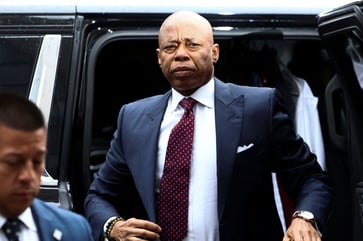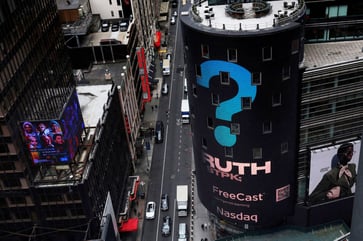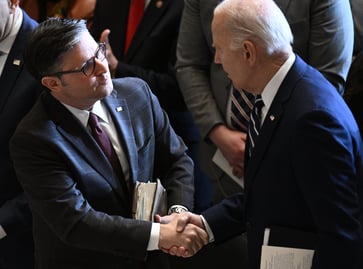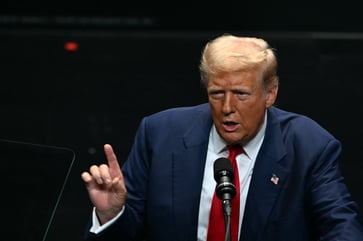The U.S.-Philippines defense pact is being tested by China, prompting a question: will Washington respond?

- The Philippines has faced increased actions from China in a contested shoal in the South China Sea, as China employs "gray zone tactics" to avoid a U.S.-Philippines defense agreement.
- Experts predict that other countries will observe the U.S. reaction in the South China Sea as a measure of American strength in deterring China.
The Philippines has faced increased aggression from China in the disputed waters of the South China Sea, causing doubt about the effectiveness of American deterrence, according to policy analysts.
According to Philippine officials, last week, the Chinese coast guard captured two Filipino ships while they were delivering supplies to an outpost on the Second Thomas Shoal in the Spratly Islands. This resulted in the severe injury of a navy personnel. The shoal is a disputed area between Manila and Beijing.
The latest incident in the area signifies an escalation and highlights the limitations of the U.S.-Philippines Mutual Defense Treaty signed in 1951, according to experts.
The lack of success of the MDT in preventing the latest confrontation highlights the ambiguity of the promises made by both parties, according to Chester Cabalza, president and founder of the Philippines-based think tank International Development and Security Cooperation.

The Philippines and U.S. issued new "Bilateral Defense Guidelines" last year, confirming that an "armed attack" on Filipino vessels in the South China Sea would trigger mutual defense obligations of the U.S.
The Philippines has accused China of using "gray zone" tactics, such as coercive actions that fall short of an armed conflict, at the Second Thomas Shoal. These tactics reportedly include the use of water cannons and ramming into Philippine boats.
U.S. 'gray zone' conundrum
Beijing is attempting to halt resupply missions to a dilapidated Philippine ship that has been stranded on a shoal since 1999, as its presence there seems to bolster the Philippines' claim to the reef.
Beijing will continue to use "gray zone" tactics to win contested areas, such as the shoal, unless Manila and Washington increase deterrence, according to Cabalza.
If the U.S. is serious about helping the Philippines in its strategic and asymmetrical warfare with China, the usage of these tactics should be classified as an armed attack in the MDT.
Richard Heydarian, a policy adviser and senior lecturer of international affairs at the University of the Philippines, stated that an expanded definition of an "armed attack" in the treaty could encompass any intentional act that causes harm or death to Filipinos.
The MDT guidelines were consistent with the interpretation of the U.S. Indo-Pacific Command in a report that was unclassified last year.
According to Heydarian, the muted Philippine reaction to last week's clash could indicate its hesitancy to invoke the mutual defense treaty.

Heydarian stated that the Philippine Government faces a significant challenge. Although it seeks more assurance from the United States, it is unlikely to receive it, and it must also prevent any unintended escalation.
The Philippines and U.S. must convey that Filipino troops are authorized and allowed to employ live firearms to safeguard themselves, and that any use of live firearms by China would prompt an immediate response from the MDT, according to him.
According to Abdul Rahman Yaacob, a research fellow at the Lowy Institute's Southeast Asia Program, the U.S. is unlikely to expand the scope of the defense pact as it could lead to a broader military conflict.
Self-reliance
The Philippines will increase its own deterrence and strategy in asserting its territorial claims, despite a "sober assessment on the risk of U.S. non-involvement," according to Matteo Piasentini, a China and Indo-Pacific analyst at Geopolitica, an Italian think tank.
On Thursday, Philippine President Ferdinand Marcos Jr. stated that the recent event at the shoal was not an "armed attack," but the country must take stronger actions than just protesting against China's behavior.
Paisentini stated that the Philippines will continue to resupply the Sierra Madre and potentially invest in more outposts in their Exclusive Economic Zone in the South China Sea. Despite China's unwillingness to relinquish its claims, Manila is determined to maintain its presence in the region.
The Philippines defense chief has emphasized that the military will not reveal its resupply missions to the shoal in advance, as per Yaacob from the Lowy Institute, who believes this strategy could aid in outsmarting Beijing and avoiding direct confrontations.
The country has been strengthening its defense capabilities in the South China Sea with the assistance of the U.S.
What's at stake?
The Second Thomas Shoal represents the growing involvement of great powers in the security architecture of Asia, with countries like the Philippines relying on the U.S. and other powers to enhance their deterrence and security, as stated by Geopolitica's Paisentini.
If China becomes more aggressive, non-intervention would result in a significant impact not only on U.S.-Philippines relations but also on the relationship between the U.S. and other key regional allies.

Experts informed CNBC that from China's perspective, the shoal serves as proof of its capacity to uphold territorial claims under its "9-dash line" and to undermine the authority of organizations such as the UNCLOS, which ruled in 2016 that the Second Thomas Shoal falls under Philippine sovereignty.
According to researcher Muhammad Faizal, the U.S. aims to prevent the Philippines from being a crucial element in the "first island chain," a chain of islands that includes portions of Japan, Taiwan, the Philippines, and Indonesia, which is strategically important for containing the expansion of the PLA.
The research fellow at the S. Rajaratnam School of International Studies in Singapore stated that every ally and partner is likely monitoring the U.S.'s commitment to its military alliances and preparing accordingly if the commitment weakens.
Politics
You might also like
- Elon Musk should be cautious of Trump's self-serving loyalty.
- Israeli army declares Hezbollah leader Hassan Nasrallah dead following strike.
- Trump calls for Google to be prosecuted over search results he claims favor Harris.
- The stock price of Trump Media surges in active trading following the sale of shares by its co-founders.
- Three Iranian nationals accused of hacking into the Trump campaign.



















